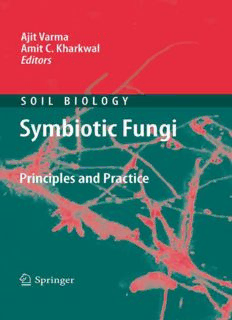
Symbiotic Fungi: Principles and Practice PDF
Preview Symbiotic Fungi: Principles and Practice
Soil Biology Volume 18 Series Editor AjitVarma,AmityInstituteofMicrobialTechnology, Amity University Uttar Pradesh, Noida, UP, India Volumespublishedintheseries AppliedBioremediationandPhytoremediation(Vol.1) A.Singh,O.P.Ward(Eds.) BiodegradationandBioremediation(Vol.2) A.Singh,O.P.Ward(Eds.) MicroorganismsinSoils:RolesinGenesisandFunctions(Vol.3) F.Buscot,A.Varma(Eds.) InVitroCultureofMycorrhizas(Vol.4) S.Declerck,D.-G.Strullu,J.A.Fortin(Eds.) ManualforSoilAnalysis–MonitoringandAssessingSoilBioremediation(Vol.5) R.Margesin,F.Schinner(Eds.) IntestinalMicroorganismsofTermitesandOtherInvertebrates(Vol.6) H.Ko¨nig,A.Varma(Eds.) MicrobialActivityintheRhizosphere(Vol.7) K.G.Mukerji,C.Manoharachary,J.Singh(Eds.) NucleicAcidsandProteinsinSoil(Vol.8) P.Nannipieri,K.Smalla(Eds.) MicrobialRootEndophytes(Vol.9) B.J.E.Schulz,C.J.C.Boyle,T.N.Sieber(Eds.) NutrientCyclinginTerrestrialEcosystems(Vol.10) P.Marschner,Z.Rengel(Eds.) AdvancedTechniquesinSoilMicrobiology(Vol.11) A.Varma,R.Oelmu¨ller(Eds.) MicrobialSiderophores(Vol.12) A.Varma,S.Chincholkar(Eds.) MicrobiologyofExtremeSoils(Vol.13) P.Dion,C.S.Nautiyal(Eds.) SecondaryMetabolitesinSoilEcology(Vol.14) P.Karlovsky(Ed.) MolecularMechanismsofPlantandMicrobeCoexistence(Vol.15) C.S.Nautiyal,P.Dion(Eds.) PermafrostSoils(Vol.16) R.Margesin(Ed.) AdvancesinAppliedBioremediation(Vol.17) A.Singh,R.C.Kuhad,O.P.Ward(Eds.) Ajit Varma Amit C. Kharkwal l Editors Symbiotic Fungi Principles and Practice Editors Prof.Dr.AjitVarma Dr.AmitC.Kharkwal DirectorGeneral Lecturer AmityInstituteofMicrobialTechnology AmityInstituteofMicrobialTechnology(AIMT) AmityUniversityUttarPradesh AmityUniversityUttarPradesh(AUUP) &ViceChairman Sector125 AmityScience,Technology& Noida,UP201303 InnovationFoundation India BlockA,AmityCampus,Sector125 [email protected] Noida,UP201303 India [email protected] ISSN:1613-3382 ISBN978-3-540-95893-2 e-ISBN978-3-540-95894-9 DOI:10.1007/978-3-540-95894-9 SpringerHeidelbergDordrechtLondonNewYork SoilBiology LibraryofCongressControlNumber:2009926002 #Springer-VerlagBerlinHeidelberg2009 Thisworkissubjecttocopyright.Allrightsarereserved,whetherthewholeorpartofthematerialis concerned,specificallytherightsoftranslation,reprinting,reuseofillustrations,recitation,broadcasting, reproductiononmicrofilmorinanyotherway,andstorageindatabanks.Duplicationofthispublication orpartsthereofispermittedonlyundertheprovisionsoftheGermanCopyrightLawofSeptember9, 1965,initscurrentversion,andpermissionforusemustalwaysbeobtainedfromSpringer.Violationsare liabletoprosecutionundertheGermanCopyrightLaw. Theuseofgeneraldescriptivenames,registerednames,trademarks,etc.inthispublicationdoesnotimply, evenintheabsenceofaspecificstatement,thatsuchnamesareexemptfromtherelevantprotectivelaws andregulationsandthereforefreeforgeneraluse. Coverdesign:SPIPublisherServices Printedonacid-freepaper SpringerispartofSpringerScience+BusinessMedia(www.springer.com) Foreword Soold,sonew... More than 450 million years ago, plants and fungi associated to produce a mutuallybeneficialsymbiosisthatassistedplantstoinvadetheterrestrialenviron- ment,whichwaspoorinnutrientsandsubjecttodesiccationandfullsunlight.This is one of the main lessons that fossil records have transmitted to us, thanks to the reports of many paleontologists, starting with Kidston and Lang (1921). Their wonderful observations, which have been confirmed by many others, provided theevolutionarybackgroundtounderstandhowmycorrhizasareapowerfuldriving forceforthefunctioningofecosystems,supplyinglandplantswithphosphorusand nitrogen,aswellasfungiwithcarbon,whichfinallyaccumulatesinthesoil. Ontheotherhand,fewbiologicalissueshaveenteredthemainstreamofbiology in such a vigorous way as mycorrhizas. Mainly thanks to DNA technologies and genomics,newtoolstodiscoversymbiontcommunication,developmentanddiver- sityandtorevealthecontributionofeachpartnertothefunctioningoftheassocia- tion have been deciphered, thus offering breakthrough findings. Looking at the historyofmycorrhizas,itcanbeseenthatsomeveryimportanteventshavemarked recent years: the first sequenced genome of Laccaria laccata (Martin et al. 2008) opened a window on the secrets of ectomycorrhizal fungi thriving in forests and associatedwithwoodyplants;theidentificationoftheplantgenesthatcontrolthe signaltransductionpathwaysinarbuscularmycorrhizal(AM)legumeshasallowed ustodissectthecrucialstepsofthefungalcolonizationprocess(Parniske2008);the discoverythatplantmolecules,strigolactones,areperceivedbyAMfungiandact as‘‘branchingfactors’’(Akiyamaetal.2005)representsalandmarkinourknowl- edge,buthasalsoledtoasecondveryrecentdiscovery.Strigolactoneshavebeen foundtoimpacttheplantphenotype,representinganovelclassofendogenousplant hormones that are present in a wide range of angiosperms from Arabidopsis thalianatorice(Gomez-Roldanetal.2008;Umeharaetal.2008). But mycorrhizas also go beyond the issue of plant/fungal biology by occupying newfields,likethatofenvironmentalmicrobiology,andbypushingthedevelopment ofnewapproaches,likethoserequiredformetagenomics.Whilethefoundationsetup by Craig Venter, the world-renowned genome research pioneer (www.jcvi.org/), v vi Foreword hastheaimofexploringthemicrobialdiversityintheworld’soceans,thedreamof soilmicrobiologistsinsteadistounderstandwhatthecreaturesthatliveinthesoil aredoingthere(Dance2008).However,intherhizosphere,thethinsoillayerwhere roots and soil microbes interact (Little et al. 2008), mycorrhizal fungi with their diverseguildsofassociatedmicrobes(bacteria,endophytes,saprotrophs)prolifer- ate and dominate. To detect and quantify microbes in this environment, where researchersbelievetheycanfindtheworld’swidestbiodiversity(Dance2008),will beoneofthemostexcitingchallengesforthescientificcommunityworkinginthe mycorrhizalfield.Thiswillmeanovercomingsomeofthereductionismsrelatedto laboratorypracticesandmovingintothefield,usingupdatedhigh-throughputDNA sequencing technologies and large-scale genomic analysis. The development of such new platforms could lead to new paradigms, i.e. the description of mycor- rhizasastheresultofmultipleorganisminteractionsandfunctioning. Thechaptersinthisbookmirrorthismixtureofoldandnewconcepts,starting from the seminal concept of symbiosis, which is central in the evolution of complexityandiscriticaltothelifestylesofmanyanimalsandplants,andalsoto whole ecosystems, in which symbiotic organisms are key players (Moran 2006). The main aim of the book, however, is to combine the impetuous increase in knowledge concerning mycorrhizas with the best laboratory practices. Expert researchersillustratethemostupdatedtechniquestodealwithold/newquestions. Lastly,researchersenjoyinvestigatingmycorrhizassincetheyareawareoftheir importance on the sustainability of our ecosystem. In this context, some chapters aredevotedtotechnologiesaimedatimprovingthequalityofmycorrhizalinocula, thusincreasingtheirapplicationrangeintheframeofamorefriendlyagriculture. ThisSoilBiologyvolumecansurelyoffermanyrepliestothecurrentquestions concerningthewayinwhichwecanunlockthepotentialofmycorrhizalfungi,in ordertomakethemaresourcethatwillbecomeavailabletoeverybody. Torino January2009 PaolaBonfante References Akiyama K, Matsuzaki KI, Hayashi H (2005)Plant sesquiterpenes induce hyphal branching in arbuscularmycorrhizalfungi.Nature435:824–827 DanceA(2008)Whatliesbeneath.Nature455:724–725 Gomez-RoldanV,FermasS,BrewerPB,etal.(2008)Strigolactoneinhibitionofshootbranching Nature455:189–194 KidstonR,LangWH(1921)OnOldRedSandstoneplantsshowingstructure,fromtheRhynie Chertbed,Aberdeenshire.PartV.TheThallophytaoccuringinthepeat-bed;thesuccessionof the plants throughout a vertical section of the bed, and the conditions of accumulation and preservationofthedeposit.TransRSocEdinb52:855–902 Foreword vii Little AE, Robinson CJ, Peterson SB, Raffa KF, Handelsman J (2008) Rules of engagement: interspeciesinteractionsthatregulatemicrobialcommunities.AnnuRevMicrobiol62:375–401 MartinF,AertsA,Ahre´nD,BrunA,DanchinEG,etal.(2008)ThegenomeofLaccariabicolor providesinsightsintomycorrhizalsymbiosis.Nature452:88–92 MoranNA(2006)Symbiosis.CurrBiol16:R866–R871 Parniske M (2008) Arbuscular mycorrhiza: the mother of plant root endosymbioses. Nat Rev Microbiol6:763–775 UmeharaM,HanadaA,YoshidaS,AkiyamaKetal.(2008)Inhibitionofshootbranchingbynew terpenoidplanthormones.Nature455:195–200 Preface It has been a pleasure to edit this manual. The final outcome is the result of our painstaking effortsinvolving a passionate discussion with eminent scientists from across the globe working on symbiosis, students and fellow colleagues. The first edition of Mycorrhiza Manual edited by Ajit Varma was published in 1998 by Springer. This new edition is published as a volume under the banner of the Soil Biology series as Symbiotic Fungi: Principles and Practice. The timing of the present edition has coincided with tremendous technical progress that has been madeintheareaoffungalsymbiosis.ThethirdeditionofMycorrhiza—Genetics and Molecular Biology, Eco-Function, Biotechnology, Eco-Physiology, Structure and Systematics, edited by Ajit Varma, appeared in July 2008. This leads to enormous demand for the protocol book to carry out the laboratory exercises and fieldtrials. Growing on mineral particles and decaying organic matter, and living in the vicinity of or within plant roots, are a diverse array of fungal species, many of which form diverse symbiotic associations with plant roots. These symbiotic associations that form between the roots of most plant species and fungi are very well-known.Theyarecharacterizedbybi-directionalmovementofnutrientswhere carbon flows to the fungus and inorganic nutrients move to the plant, thereby providing a critical linkage between the plant root and soil. In infertile soils, nutrientstakenupbythefungicanleadtoimprovedplantgrowthandreproduction. Asaresult,theseassociationsareoftenmorecompetitiveandbetterabletotolerate environmental stresses than other plants. The book contains the current state of practiceonmanyaspectsofsymbioticfungiandassociatedmicrobes.Itdealswith organismic interactions, diversity of microbial communities, mycorrhizal bioas- says, nutrient transfer techniques, restoration ecology, AM inoculum procedures, biotechnologicalapplication,microbialcommunicationandmushroomtechnology. Itwillbeofinteresttoadiverseaudienceofresearchersandinstructors,especially biologists, biochemists, agronomist, foresters, horticulturists, mycologists, soil scientists,plantphysiologists,microbiologistsandmolecularbiologists. It is hoped that the protocols proposed by the authors will stimulate further research, as the information presented tends to highlight both the need for further ix x Preface work in this challenging field and the lack of agreement on some fundamental issues. Inplanning thisvolume, invitationsfor contributionswere extended toleading international authorities working with symbiotic fungi. We would like to express oursincereappreciationtoeachcontributorforhis/herwork,andfortheirpatience andattentiontodetailduringtheentireproductionprocess.Wesincerelyhopethese eminentcontributorswillencourageusinthefutureaswell,inthegreatestinterest ofacademia. TheencouragementandinspirationreceivedfromDr.AshokKChauhan(Founder President, Ritnand Balved Education Foundation), Sri Atul Chauhan (Chancellor, Amity University Uttar Pradesh), and Sri Aseem Chauhan (Chancellor, Amity University Rajasthan) need special mention. We are extremely grateful to the staff membersofSpringerHeidelberg,especiallyDieterCzeschlikandJuttaLindenborn, fortheircontinuedinterest,criticalevaluation,constructivecriticismandsupport.We wish to acknowledge the help and support given to us by our students, faculty colleagues,familymembersandfriendsfortheirconstantencouragement. AmityUniversityUttarPradesh,India AjitVarma January2009 AmitC.Kharkwal
Description: